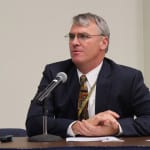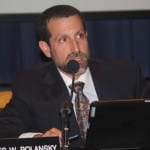The site of the former Steck-Philbin Landfill in Kings Park was slated to be repurposed this year as part of a countywide effort to eliminate blighted properties, as the Suffolk County Legislature approved a contract with Powercrush Inc. and Vision Associates LLC to develop on the land. However, another business that put in a proposal for the landfill site has criticized the deal and has called for an investigation of the operations of Suffolk County Landbank Corp. for development of public properties.
Shawn Nuzzo, president of Ecological Engineering of Long Island, said he believes Powercrush and Vision Associates “had neither the ability nor the good-faith intention to build a solar farm and that the Suffolk County Landbank was either willingly complicit or, at a minimum, completely inept during this process.”
In a letter and phone interview Nuzzo brought up the connections Powercrush has with donating to political campaigns — including two members of the Suffolk County Legislature — and said the current approved resolution that does not state the contract will include a solar farm on the property.
In January 2016, the county landbank, a not-for-profit entity that works with the county to redevelop tax-delinquent properties, issued a request for proposals to revitalize eight brownfields, including the landfill in Kings Park. About two months later Nuzzo’s company submitted a proposal for a 6-megawatt solar farm that he said could generate nearly 8 million kilowatt hours of solar electricity in its first year. He also said EELI would finance, build and operate the solar farm through a crowdfunding campaign, seeking small investments from everyday Suffolk County residents. The plan would be to sell 25,000 “solar shares” in the farm at $500 each. Some local officials threw their support behind Nuzzo, including state Assemblyman Steve Englebright (D-Setauket) and Brookhaven Town Councilwoman Valerie Cartright (D-Port Jefferson Station).
Out of the several proposals given to the county, the plan with Powercrush, a Kings Park company, was selected to move forward, with the same goal of reusing the site for solar farming. County Executive Steve Bellone (D) praised the plan as a turning point for dealing with blighted properties, and Amy Keyes, executive director of the county landbank, said in a past interview Powercrush was selected based on a number of qualifications, including design, impact and feasibility.
County Legislature Presiding Officer DuWayne Gregory (D-Amityville) said the creation of the county landbank was his idea, and the process of selecting Powercrush and Vision was “completely fair.” He said claims that landbank operations are in need of an investigation are “not a credible argument.”
“We evaluated those proposals based on merit, [EELI] came up short,” Gregory said in a phone interview. “These were cases of not being able to say what you can do, but being able to do what you can say, and the strongest proposal with the best benefit to the taxpayer was Powercrush. Each proposal got a score sheet and they scored the highest.”
Nuzzo said he tried to see the winning proposal, to compare it to his own and see how his company could improve for the future, but he was unsuccessful.
“I can only speculate that the winning proposal was so inadequate and incomplete that the county is embarrassed to share it,” he said in a previous interview. “It’s a shame, because our proposal to build Long Island’s first community-owned solar farm could have been a landmark moment for Suffolk County. Instead what we got was politics as usual.”
Nuzzo said he also had an issue with the fact that the development may no longer be a solar farm. After the original resolution was passed by the Legislature, which included the intention of building a solar farm, an amended resolution was passed this past March that approved moving forward with the Powercrush and Vision contract without the language of it being a solar farm.
“If the selected bidder is unwilling or unable to develop the land in accordance with their proposal, then their bid should be voided,” Nuzzo said. “Powercrush and Vision Associates were awarded this parcel based on their plan to construct a 4-megawatt solar farm.”
Nuzzo said he’s concerned with the system as a whole.
“This is about how Suffolk County issues its contracts,” he said. “This is more of a condemnation of the system as a whole.”
However Sarah Lansdale, president of the county landbank, said a solar requirement was never a part of the original proposal from the county.
“There was nothing requiring the end use had to be a solar farm,” Lansdale said in a phone interview. “There was no foul play here. They proposed solar and if they didn’t win the contract with PSEG the redevelopment site still needs to be something acceptable to the community.”
Powercrush and Vision did lose their bid with PSEG Long Island for a power purchase agreement. However Mike Rosato, of Vision Associates, said a solar farm idea had not been scrapped.
“The original [proposal from the county] did not require a solar farm, but yes this might still be a solar project,” he said in a phone interview. “The whole idea of this project is to make something good for the community.”
Rosato said in a letter their proposal was chosen for many reasons including financial capacity to successfully implement the project and demonstrating the experience to successfully carry out the project; demonstrating the ability to start the remediation and redevelopment process within six months of tax deed transfer; and improving the environmental condition of the property.
“Although our solar partner lost its bid with PSEG Long Island, we clearly stated in our original proposal that in the event this were to happen we would work to identify another industrial end use that would be acceptable to the community and permitted by the [Town of Smithtown],” Rosato said. “Our intentions have always been to reuse the site for renewable energy and we will continue to pursue that objective.”
As for Nuzzo’s concerns with political ties, he pointed out Toby Carlson, owner of Powercrush, has donated to several political campaigns, including county Legislators Rob Trotta (R-Fort Salonga) and Steve Stern (D-Dix Hills). Trotta recused himself from the Legislature votes on this issue, and said he has repeatedly tried to convince Rosato not to invest in this property because of the extensive work required to make it functional.
“If the original [proposal from the county] had required solar I would be screaming and [Nuzzo] would be 100 percent right,” Trotta said in a phone interview. “But it didn’t, that’s just not true.”
Stern did not return any requests for comment.







































